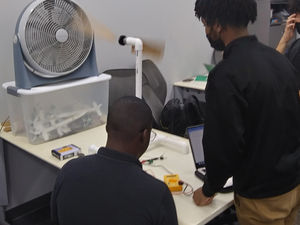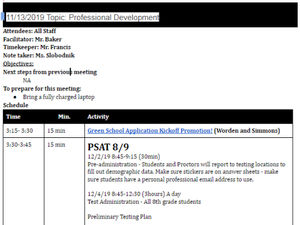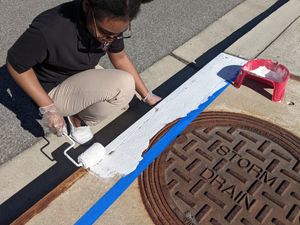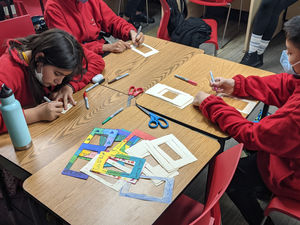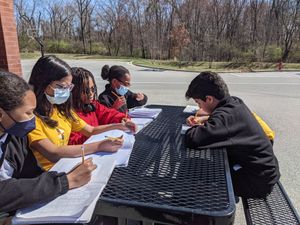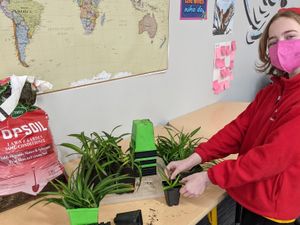Systemic Sustainability
Environmental Curriculum and Instruction
1.1 Curriculum and Instruction
Elementary & middle schools must provide one example of outdoor/environmental instruction per grade level.
High schools must provide one example of outdoor/environmental instruction in four subjects (which may include multiple different differents sciences).
In e4usa, engineering essentials, 11th and 12th grade students investigated the potential impact of wind turbines. Over a 1-month period, we discussed the sources or electrical power in our region and their long term effects on the environment. Students then worked in groups to test a specific variable relating to wind turbine blade design. The results of these tests were used to inform decisions in creating a wind turbine blade that would work best with average wind velocities in our region.
As a culminating activity for our unit on natural resources and human impacts on the environment, students were tasked to design a home that incorporated green technology and other plans for sustainable living. "How could a home be designed to reduce use of fossil fuels & best utilize renewable energy sources?" was the guiding question for the design. Additional prompts were given to have students explain why they chose certain elements and what positive effects would be generated by utilizing their design.
Green House design (87.97 KB)
Guidance for activity and examples (student work) of responses from four student groups.
Green Houses (674.34 KB)
"Green" House designs (student work) from three student groups.
One sometimes-overlooked environmental issue that is nonetheless pressing is the rapid decline in many pollinator species. For this seventh-grade science activity students were tasked with researching a problem facing two pollinators of their choice as well as ways that we can help support these pollinators. They summarized and displayed their findings through creating an infographic to highlight key pieces of data and information. This project was introduced after lessons about plant and animal reproduction were delivered and was an excellent opportunity for students to apply the concepts that they recently learned about. This active exploration of an environmental issue allowed students to find out more about the online resources available to them in the pursuit of learning more about the challenges facing our planet. Perhaps more importantly, through finding and explaining potential solutions to these challenges students were able to see that we can all make contributions to heal our environment and create positive change.
My 8th graders had team brainstorming sessions and then a whole group discussion about protecting our environment. They created posters to illustrate good practices everyone can do to help; like reducing pollution. Captions like using renewable energy, intensifying recycling, reusing items, stop littering, and plant trees, accompany their artwork. The posters are displayed in the school hallways now so all staff and students can view them.
In 2010 petroleum giant BP spilled millions of liters of crude oil into the Gulf of Mexico. Vast quantities of chemical dispersant was sprayed on the spill to break up the oil. However people started to get sick and it became a health catastrophe. Students used materials such as cotton balls, paper towels, plastics straws, and dish detergent to clean up their own spill and analyze which materials eliminated the most oil.
Students completed a lab regarding the effects of acid rain due to pollution to building structures and marble statues. They identified a safe hydrochloric acid concentration that will slow down the rate of this process or minimize the effects of acid rain.
Students discussed and presented their findings and came up with 2M HCl or less to be the least harmful to the environment when it comes down as acid rain. They estimated how long would it take for a marble statue to disintegrate using the approximate size of the statue and the frequency of rain in the area.
Because it's not always simple to see, it can be challenging to understand what air pollution is. Students applied petroleum jelly to a petri dish and left it uncovered for twenty-four hours. The next day, it was examined to check for particles that had collected on the surface overnight.
Students tried to identify the particles in their samples and to infer what sources they came from. Two potential causes are dust and mold spores. Groups discussed additional sources they might encounter at home, such as pet dander and cigarettes, and what methods might help to reduce exposure to indoor particles and air pollution in general.
1.2 Green School Awareness
1.2.1 School Wide Awareness - Staff
Demonstrate that all school personnel are aware of your school's Green School status and application process.
The presentation regarding plans to apply for Green School certification was originally made during a monthly all-staff meeting in November 2019. An invitation to join the Green Team was issued and examples of support needed from staff were also described. Our timeline was delayed due to school closure during the pandemic. We are back on track this year.
Email to all staff reminding all that College Park Academy is officially applying for Green School Certification this year. We started the process in 2019, when we first introduced the program at a whole-staff meeting.
1.2.2 School-Wide Celebration
Demonstrate how your school celebrates beig a Green School by hosting a school-wide environmentally-focused event open to all students.
College Park Academy celebrated activities our staff, students, and Environmental Clubs have been participating in over the last two years while working towards our first Green School application.
The entire school participated in a week of activities from March 13-17, 2023; with green tips during morning announcements and an environmental focus action for each day.
The Week Ahead (89.96 KB)
"The Week Ahead" is an announcement sent by email to all school community members as a preview to the next week's activities. Our Be Green Every Day schedule was listed there as another method to inform students, staff, and families.
Environmental Professional Development for Teachers
1.3.1 Environmental Professional Development for Teachers
Demonstrate that 10% of staff have completed an environmental PD. Instructional staff is defined as any staff that manages a gradebook.
- New Schools must have all PD completed within the past 2 academic years.
- Renewing schools must have all PD completed within the past 4 academic years.
A teacher who has participated in multiple workshops may only be counted once..
Professional development attendance by staff.
This PD was an introduction to the En-ROADS climate solutions simulation model. It is a highly interactive, role-playing game for engaging participants in exploring key technology and policy solutions for addressing global warming. Students will use the game to propose climate change solutions and see what it would really take to address this global issue.
Certificate of Completion (72.26 KB)
Worden: Climate Solution Simulation
The MD Green School Program - A Beginner's Guide session was to introduce schools to the new online platform for the 2023 application. It was also an opportunity to receive training and assistance in developing an action plan to complete the Green School application process .
Certificate Of Completion (SF) (72.36 KB)
Flood: MD Green School Program
This professional development provides a general overview of what environmental literacy is and requires participants to develop their own conceptualization of environmental literacy. Participants illustrate what e-literacy is to them and develop a working definition. The self-paced course provided a historical perspective of e-literacy and show how it can be embedded in k-12 curriculum.
Certificate of Completion E. Slobodnik (298.06 KB)
Slobodnik: What is Environmental Literacy?
This professional development provides a general overview of what environmental literacy is and requires participants to develop their own conceptualization of environmental literacy. Participants illustrate what e-literacy is to them and develop a working definition. The self-paced course provided a historical perspective of e-literacy and show how it can be embedded in k-12 curriculum.
Certificate of Completion J Chung (297.76 KB)
Chung: What is Environmental Literacy?
This professional development provides a general overview of what environmental literacy is and requires participants to develop their own conceptualization of environmental literacy. Participants illustrate what e-literacy is to them and develop a working definition. The self-paced course provided a historical perspective of e-literacy and show how it can be embedded in k-12 curriculum.
Certificate of Completion Julie Mamunes (309.51 KB)
Certificate of Completion
This professional development provides a general overview of what environmental literacy is and requires participants to develop their own conceptualization of environmental literacy. Participants illustrate what e-literacy is to them and develop a working definition. The self-paced course provided a historical perspective of e-literacy and show how it can be embedded in k-12 curriculum.
Certificate of Completion Jennifer Miranda (309.44 KB)
Certificate of Completion
This professional development provides a general overview of what environmental literacy is and requires participants to develop their own conceptualization of environmental literacy. Participants illustrate what e-literacy is to them and develop a working definition. The self-paced course provided a historical perspective of e-literacy and show how it can be embedded in k-12 curriculum.
Certificate of Completion Rebekah Benson-Flannery (310.13 KB)
Certificate of Completion
1.4 Achieving Sustainable Schools
1.4.1 School-Wide Staff Sustainability
Demonstrate the sustainability practices your teachers, staff, and other personnel have implemented school-wide to make your school green. Any actions involving students belong under Objective 2.
Staff meeting agendas and weekly newsletters are electronic.
Double-sided copying is the default setting for staff accounts when sending jobs from our devices to print and when copying at the printer.
Coffee Corner #16 (406.41 KB)
The weekly electronic newsletter for staff. A reduced version is posted for students and families.
1.4.2 Systemic Partnership
Demonstrate one partnership with a central office or board within the school system that supports part of the Maryland Green Schools Program. Any partnerships outside of your school system belong under Objective 3.
PGCPS, Department of Building Services works with schools to set goals to reduce solid waste. A Waste Reduction Plan is submitted to help select targets with the aim of reusing, or recycling, solid waste items. The school selects a recycling coordinator, who works with the building supervisor, to meet the goals put forth by the coordinator and the principal. Building supervisors are also pivotal in monitoring the pick up of recycling is carried out according to schedule.
College Park WR Plan (739.42 KB)
Solid Waste Reduction Plan SY22-23
Student Action
Schools must document eight total actions that address at least three of the listed sustainability practices.
These are student actions not adult actions. Adult sustainable actions can be documented in Objective 1.4.
2.1 Water Conservation/Pollution Prevention
2.1 Water Conservation/Pollution Prevention
Students celebrated Earth Day by removing litter from the schoolyard and surrounding area to reduce the possibility of the litter reaching the waterways.
Students from the high school Environmental Club got their first experience with storm drain stenciling. The message is an important reminder that they flow directly into streams and other waterways. Rain will carry any trash or contaminants off the street and down the drain until eventually reaching the Chesapeake Bay.
Their team will be the lead for the next round of stenciling.
2.2 Energy Conservation
2.2 Energy Conservation
Students from the Middle School Environmental Club made and hung labels for the light switches throughout the school to encourage energy conservation and reduction of our impact on climate change.
2.3 Solid Waste Reduction
2.3 Solid Waste Reduction
Students use recycling and trash containers in cafeteria help keep items separated so they can be taken to the proper receptacle outside for pick up. Students post recycling signs in classrooms and offices throughout the building.
Middle School Environmental Club members collected broken and unwanted holiday light strings at school and from their neighbors. Announcements were sent to staff, students, and their families through our school virtual communication lines.
Holiday Lights (95.14 KB)
Announcement to staff about collection of light strings.
2.4 Habitat Restoration
2.4 Habitat Restoration
Students planted a pollinator garden on campus. Native plants and tools were provided by the Schmidt Center. Members of our middle school environmental club installed the plants in one of the dry stormwater detention ponds fronting our campus.
During our Good Neighbor Day event, students, families, and community volunteers cleared invasive plant species to establish an area where native plants can thrive.
Good Neighbor Day is an annual partnership between the University of Maryland, the City of College Park, and the Maryland-National Capital Park and Planning Commission (M-NCPPC) that brings together residents of College Park and surrounding communities with university students, staff, faculty, and alumni for a day of service.
2.5 Opportunities for Nature Exploration
2.5 Opportunities for Nature Exploration
Picnic benches are located in the back of our school building. We're also lucky to have a curtain of trees and plants on 3 sides of campus that separate us from the surrounding roads and houses. Starting in the early fall, classes use the benches or nearby grassy area to have a lesson outside during good weather. Grade 6 worked on making observations of nature in our backyard; inferring cause and effect, and generating new questions.
Students writing about their observations in their class notebooks.
View of a section of our "back yard" from the area of tables.
backyard obs (1.44 MB)
Students' observations of nature at College Park Academy. All observations were taken outdoors on benches or while seated in the grass.
2.6 Responsible Transportation
2.6 Responsible Transportation
Neighborhood students and their families have coordinated their own carpools to and from campus. Other students walk, or ride bikes and scooters together. Our current bike racks are filled and more will be installed to accommodate the growing need.
2.7 Healthy Indoor Environments
2.7 Healthy Indoor Environments
Students transplanted spider plants in order to promote better air quality in the classroom. Each classroom received a plant to care for during part of the school year.
2.8 Citzen/Community/Participatory Science
2.8 Citizen/Community/Participatory Science
No records were added by the school.
Community Partnership
Demonstrate that your school is forming long-term partnerships to foster environmental stewardship and cultivate community wellness through real-world connections.
3.1 Community Partnerships
3.1.1 School Active in Community
Describe at least one environmentally-focused partnership in which your school is working to benefit your community.
The 8th Grade Class started a shoe drive in December, which ran all the way through March. All donated shoes are redistributed throughout the Funds2Orgs network of micro-enterprise partners to help create, maintain, and grow small businesses in developing countries where economic opportunity and jobs are limited. Proceeds from the sales of the shoes collected during the drive are used to feed, clothe, and house their families. This process also provides a second life for the resources used to produce the shoes and reduces solid waste.
shoe drive flier (605.07 KB)
Flier announcing the shoe drive, which was posted at school and included in our weekly communications home.
update for drive end (141.35 KB)
Communication with partner organization about wrapping up the drive.
3.1.2 Community Active in the School
Describe at least one partnership in which a community partner is benefitting the school. These actions and projects occur on or near school grounds with support from the partner.
Students installed a pollinator garden on campus with plants donated by and tools borrowed from the Schmidt Center.
CPA garden tool loan doc (313.17 KB)
Garden tool checkout form.
3.2 Additional Achievements
3.2 Additional Achievements optional
Share any environmentally-related awards, special recognition, certifications, or other achievements that your school, staff or students have accomplished.
No records were added by the school.

